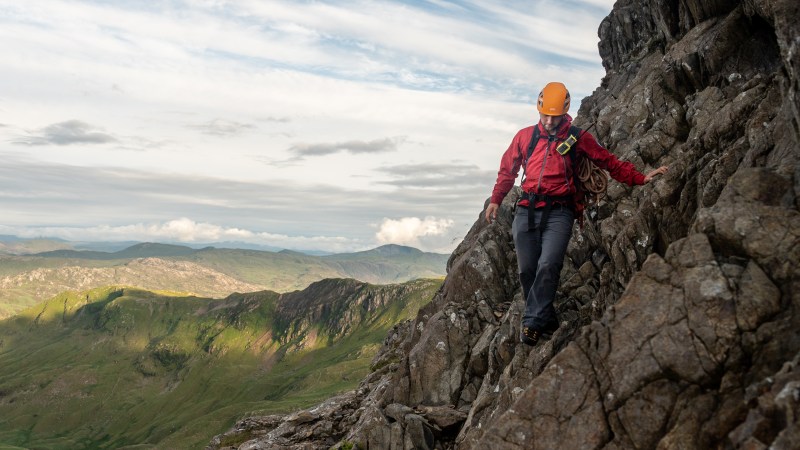‘Instagram tourism’ pushes mountain rescues to record high
From the peaks of Scafell Pike to Snowdon and Ben Nevis, mountain rescue teams are in high demand because of a zest for the outdoors prompted by Instagram.
While volunteers are delighted that visitors are sharing views from Britain’s highest peaks on social media, the trend appears to have spurred climbers with more enthusiasm than sense.
The 12 mountain rescue teams in the Lake District were projected to have handled a record 714 emergency calls last year. The average for the previous seven years was 602 and has never surpassed 681.
The Llanberis mountain rescue team responds to emergencies on Snowdon, known in Welsh as Yr Wyddfa, and reached 305 incidents by mid-December, which is a record for a single team in Britain. Before 2008 the team had never had more than 100 incidents a year.
Lochaber, the team responsible for Ben Nevis, the tallest peak in Britain, reached 158 rescues in mid-December, higher than the 154 recorded for the whole of 2022.
Phil Kirby, chairman of Langdale Ambleside Mountain Rescue in the Lake District, put the trend down to “Instagram tourism”.
“It’s a term we picked up from our colleagues in Norway a few years ago,” he said. “It’s people seeing pictures of places on the internet and saying: ‘I’ve got to go and see that’.”
Visitors not only wish to replicate the photos, but take selfies at the beauty spot.
In Norway the honeypot for tourists is Pulpit Rock, a natural platform with spectacular views over a fjord.
Kirby said: “People trek up to this thing and the weather changes. They’ve had up to 30 people they’ve had to get off.
“Instagram has expanded people’s awareness of places they can go. They pick it up and think ‘I’ll go there’ but without the necessary preparation.
“It’s just the way we are now. We have access to so many things we didn’t have.”
There have also been a small number of emergency calls caused by the trend for wild swimming, including one on Christmas Day last year.
Rescue volunteers became so concerned that they set up adventuresmart.uk, a site that encourages trekkers to take simple precautions that could prevent hundreds of callouts each year. Most rescues result from people failing to take basic equipment such as waterproofs or boots, to check the weather forecast beforehand and to recognise when they should return home.

Dr Richard Griffiths, chairman of Llanberis Mountain Rescue, said that volunteers were finding it hard to balance their commitment to help others with their personal lives as callouts became more frequent.
“As we get busier and busier there is a very real risk that the service becomes overloaded and we are not able to respond to those in need quickly,” he said.
Llanberis’s 56 operational team members have completed more than 8,000 hours of rescue work last year on top of other duties such as training.
“As a group of volunteers we are nearing the limit of what we can do to support those in need in the mountains,” Griffiths said.
Mike Smith, a director of Lochaber Mountain Rescue, suggested that people were embracing outdoor life after the pandemic. His team, which increased from 35 to 50 people a year ago, has spent about £40,000 on new equipment in recent weeks. The money comes from public donations.
“If we were to speculate on it, we would put it down to increased activity in outdoor spaces. The NHS are encouraging people, rightly, to go out into outdoor space.”
Kirby, 70, said that the biggest curse has been the false sense of security provided by smartphones. Google Maps is ill-suited to mountain navigation and even the more specialised maps of Ordnance Survey are only good for as long as the phone’s battery lasts.
“If you’re using anything with a battery in cold weather, the battery performance degrades far quicker, so by mid-afternoon you can have very little battery left.
“I’ve been out on Christmas Day and somebody was in exactly that situation. He had spare batteries but they suffered in the same way the phone did. The cold just sucked the power out.”
Kirby added that a map, compass and torch were far more reliable in an emergency but that they were unfashionable and some people did not know the basics of map reading.
“It relies on common sense, which is far from common these days,” he said.
On a pleasant day in the valley it could be at freezing point on the peaks, according to Kirby. He said: “3,000ft up it’s a different environment. If you’ve not done it before, you wouldn’t know.”
Penny Kirby, of Wasdale and Eskdale Mountain Rescue, said that in the 1970s there would be 12 callouts a year for her colleagues. This year her team has responded to more than 150.
“I think because it’s called a park, people have the idea that it’s very manicured, it’s safe but where I am there are no made paths, there are no signposts,” she told the Radio 4 programme Open Country. “There’s no café at the top and the weather can be just hideous. Very quickly it can change, and that catches people out.”
She urged people to make sure they went out with proper clothing, food, water and a torch each. “I think people have got out of the way of being so self-reliant.”






